Imperial Treasury
The Treasury
The palace originally contained several treasury areas. For example, in one room was kept the so-called “Ambassadors Treasure” consisting of the rich objects which were used by Ottoman representatives abroad, and kept here when not in use. In addition, the relics of the Prophet Mohammed, the Inner Treasury, and the Equestrian Treasury were each separately housed. It is believed that the original treasures of the Sultans were kept in the Seven Towers Gate section of the City Walls. The collection we see now consist of gifts of ambassadors, enthronement gifts, and purchases of the Sultans themselves. The largest treasure from the spoils of war was added by Sultan Yavuz Selim, whose seal closed the treasury doors until recent times in recognition of his accomplishment.
The artifacts of the treasure were deposited in closets and chests until the time of Abdulmecit. According to Palace laws, each Sultan was to visit the Treasury after his enthronement. When Abdulmecit made the customary visit the ordered that some of the items be placed on exhibit during the Crimean War. Following in his steps, Abdulaziz and Abdulhamit II. also exhibited some items. From time to time foreign ambassadors were also shown the collection which we now see. The sultan himself was alone allowed to enter the treasury, or in his absence, a group of forty men together. The collection was filled and emptied many times over because of the constant flow in and out of gifts to and from the courts of the world. Each year a gift was sent to the grave of the prophet Mohammed, some of which are now returned and seen today.
Treasury Salon I
Entering on the right we see a case containing the amour or Sultan Mustafa III. The suit is of iron mail, encrusted in gold an precious stones. It offered full protection from head to toe, and included sword and shield and foot gear for his mount. In the second case are shown Koran covers decorated with pearls, for the personal use of the Sultans. Of particular interest is the cover in black velvet, decorated in pearls and carrying in the center a diamond “God Bless” and finished with three pearl tassels.
In the third case is the ebony throne of sultan Murad the IV., inlaid with ivory and mother - of - pearl, and covered in a fabric throw typical of 17th century Turkish handwork.
At the side, in the fourth case are shown 16th and 17th century Turkish and Iranian pots, vases, and water jugs. Opposite, in the fifth case, and belonging to the Egyptian Governor Mehmet Ali Pasha, are gold candelabras, and an 18th century gold water pipe belonging to the Governor of Van, Mustafa Pasha and several candle snips. In the sixth case, solid jade vases and ports, form a background for the diamond studded walking stick of Abdulhamit II., a gift of Kaiser Wilhelm. In the seventh case, belonging to the mother of Sultan Mahmut II. is a golden candelabra. A washing set and sherbet set, also in gold, belonging to Abdulhamit II. are representative of a high quality of gold work. Next to the door, in the eighth case is an ornate Indian music box. From here we turn to the central cases in the room, where are exhibited a large number of heavily decorated military items, in addition to many personal items belonging to members of the Sultan’s household.
Treasury Salon II
As we enter the room, on the right, in the first case are emerald praying beads, and arrow quivers of 16th century manufacture by Turkish artisans, covered in gold, measuring 35 by 67 centimeters. The quiver immediately in front of us is decorated in flower motifs done in diamonds and emeralds. In the second case at its top is a hanging pendant belonging to Sultan Abdulhamid I. of emerald, framed in gold. It is undoubtedly one of the most striking pieces in the room, containing three large emeralds shaped in a triangle, leaf patterns surround framed in gold, and 48 strings of pearls forming the tassel. Along with 97 other treasures, this tassel was originally a gift of the sultan to the tomb of the Prophet Mohammed in Mecca, and was returned to Istanbul when Mecca no longer lay within the borders of the Empire, through the efforts of Fahrettin Pasha, guardian of the treasury.
In the same case is a six-sided pendant of emerald belonging to Sultan Ahmet I. The body sits on a six pearl foot, with each of its six sides framed in gold. The cover is domed in a gold lattice, encrusted with diamonds and sapphires. The old plaque at the base indicates that it was commissioned by Sultan Ahmet I. in the year 1617 at a price of 6000 gold pieces. In the lower corner of this case, on a turban, is a 17th century plume-decorated with two five centimeter emeralds in length, formed on a heavy gold pin. Its top is decorated with two five centimeter emeralds and a garnet stone, framed by diamond-encrusted gold leaves, and loops of pearl chains. An additional pendant in this same case was commissioned by Sultan Ahmed I.
In the third case, at the top, is an emerald pendant belonging to Sultan Mustafa, and an emerald dagger belonging to Mehmet IV. This dagger is a fine example of 17th century craftsmanship, being 31 centimeters in length, its handle of solid emerald, worked in gold an other precious gems. It was a present to the Sultan Mehmet IV. at the dedication of the Yeni Mosque.
In the fourth case of this room is a very eye - catching emerald pendant, 55 centimeters in length, with a four centimeter long emerald at its top. Beneath this a gold plaque decorated in diamonds, on either side of which are inscriptions to Sultan Abdulmecid I. At its base are round and hexagonal emeralds surrounded with pearls. The tassel at the base is of seventeen strings of pearls. In the same case are found bases for Turkish coffee cups and turban tassels and plumes. In the fifth case are feather - like plumes and quivers, the emerald quiver at the bottom being particularly lovely.
Treasury Salon III
In this salon are more diamond and gold works. In the case on the right of the entrance are Koran covers decorated in precious stones. in the second case is a dessert set belonging to the Sultan Abdulhamit, as well as a gold incense burner, and an enameled sherbet set.
At the top of the third case is a pendant carrying the seal of the sultan Mahmut II., itself of diamonds, on a blue and pink enamel background. The chain is of gold, and the tassel 45 strings of 38 centimeters of pearls. In the same case is a grouping of several very large, very famous cut diamonds. The broaches, rings ad other jewelry items here are equally lovely. In the fourth case, of particular note are the gold tray and gold incense burner.
In the fifth case, perhaps this room's most beautiful object, the spoonmakers diamond, is located.
Treasury Salon IV
The central object of this room is the Turkish and Indian masterpiece in its center, the throne of Mahmut I. A gift of the Persian King Nadir Shah, on a green and red background, its designs are of emeralds and pearls. Previously thought to be the throne of Shah Ismail, research has shown it to have been in fact a gift of the Persian king to the Ottomans. On the right in a case, are pots and ivory mirrors. Across, in a large number of cases, are swords, rifles, prayer beads, spoons, all extravagantly decorated. Of particular note is the box in which the mantle of the Prophet Mohammed was once kept.
As we leave this magnificent treasury, we pass along the from of the museum’s administrative offices to the Portrait and Miniature Exhibit Hal. The ground floor of this hall contains examples or art works from the Islamic world from the 13th to the 19th to the 20th century.
|
|
Gold matara - flask This flask has a distended, flattened, pouchlike body, and a short neck, and is set on a low, circular foot. Solid golden body decorated with pearls, repousse palmettes, emeralds and rubies. |
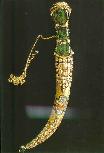
|
The Topkapi dagger, 1746. |
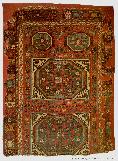
|
Bergama rug of the Holbein type 16th century. |

| The Spoonmaker's Diamond. |
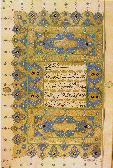
|
An illuminated page from a Koran by Ahmet Karahisari. |
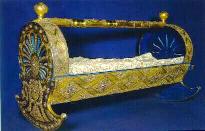
| Golden craddle, 16th century. |
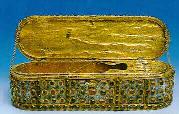
| Gold pen box. |

|
Monogrammed (tughra) pendant Height = 20cms. In the form of an ostrich egg, enamelled in blue and pink, this pendant bears the tughra of Mahmut II (1808-1839) inscribed in diamonds, and foliate and floral motifs also studded in diamonds. A small diamond-encrusted seperate lobe hangs above the pendant and a cascade of pearls below. |
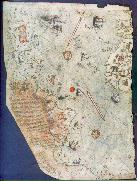
|
The map of Piri Reis The map, which is drawn on parchment in colour, was executed by the Turkish geographer Piri Reis, a renowned cartographer of the 16th century. The map shows part of Europe and west coast of Africa, and eastern, central and south America, the Atlantic islands, and the ocean. A great deal of detail is given in South America. This map is in fact only the western section of the world drawn by Piri Reis and presented to Selim I in Cairo in 1517. It was prepared in Gelibolu. Piri Reis' map is the oldest known map which includes the continent of America. |
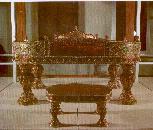
|
The throne of Nadir Shah, 18th century. Irano - Indian. This throne was presented by the Shah of Iran to Mahmud I (1730-1754). Gold, precious stones and enamel embellish the throne. |
|
| Hanging wall clock, 18th century. |
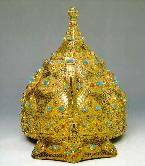
| Helmet, 16th century. |
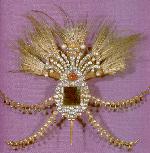
|
Sultan's crest. 18th century. 28cms in height. Bears an emerald (4x5 cms), a ruby (3 cms), and framed by a row of diamonds and pearls. |
|
|
Sweetmeat set Abdulhamid II period (1876-1909) |
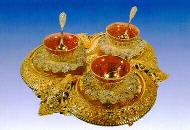
| Ice cream service, gold, cast and filigree. |
|
|
Gold ceremonial throne MAde in 1585 by order of the vizier Ibrahim Pasha and presented to Murad III. |
|
|
The throne of Ahmed I The throne was the work of the architect of Sultanahmed mosque, Mehmet Aga. |
|
|
Rock - crystal flask. This flask, or matara, was one of the ceremonial vessels used to carry water for the use of the Sultan. Last quarter of the 16th century, H. 32.2 cm, D. 15.5 cm. |
|
|
Rock - crystal flask 16th century, H. 21 cm. |
|
|
Rock - crystal jug. The body and handle of the jug are carved from a single piece of rock - crystal. The remainder is also decorated with gold and jewels. 2nd half of 16th century, H. 20 cm. |
|
|
Swords Ornamanted with gold. |
|
|
Ewer Made of silver, enamel plated. 19th century. |
|
|
Inclaided flintlock guns 18th century. |
|
|
Zinc jug with lid 16th century. |
|
|
Rose - water flask Made of gold, enamelled with flower decorations. |
|
|
Coffee - ewer Made of silver, gold plated. 19th century. |
|
|
Rock - crystal and gold jug with lid 16th century. |
|
|
Jade tankard with lid 16th century. |
|
|
Emerald and diamond broach |
|
|
Gold sherbet set Four tugra monograms of Abdulaziz are set around the rim. |
|
|
Compote service in enamel |
|
|
Rose - water flasks Made of gold, enemelled and ornamanted with diamonds. |